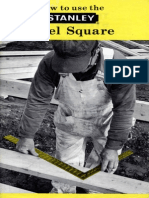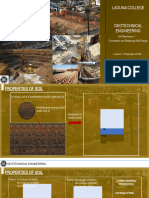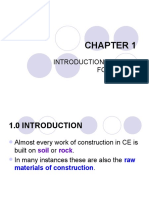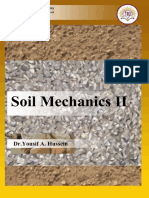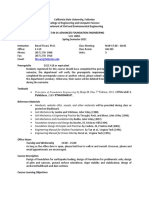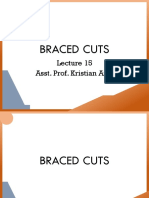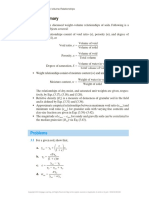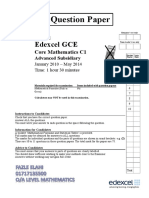Module 1 - Geotechengg PDF
Module 1 - Geotechengg PDF
Uploaded by
Dio LazatinCopyright:
Available Formats
Module 1 - Geotechengg PDF
Module 1 - Geotechengg PDF
Uploaded by
Dio LazatinOriginal Title
Copyright
Available Formats
Share this document
Did you find this document useful?
Is this content inappropriate?
Copyright:
Available Formats
Module 1 - Geotechengg PDF
Module 1 - Geotechengg PDF
Uploaded by
Dio LazatinCopyright:
Available Formats
Holy Angel University
School of Engineering and Architecture
Department of Civil Engineering
Stresses in
a Soil Mass
Module 1 – Geotechnical Engineering
Objective After the lecture, the student must be able to analyze stresses at any
point of the soil; calculate vertical stress increase due to foundations
and other external loadings applied in soil strata.
Content In this lecture we will discuss the methods of analyzing stresses in the
ground,
Review of Plane-Stress Transformation and Theory of Elasticity
Mohr’s Circle Analysis
Boussinesq’s Approach of Vertical Stress Increase
Newmark’s Influence Chart on Foundations
Activities During the module, students will perform graded activities to measure
their progress during the course; Quiz, seatwork, class discussion,
problem set computations, and recitations are expected.
Readings B.M. Das, 2011. Principles of Foundation Engineering (7th Edition)
Stamford, Connecticut, USA: Cengage Learning
Credits to: Engr. Mark Kenneth M. Tuazon and Engr. Neal Lorenzo P.
Castillo for the original and latest edited content, respectively.
Instructor: Engr. Aline Benneth V. Jacobo Page 1 of 39
Module 1 – Stresses in a Soil Mass
PART 1 – PLANE STRESS TRANSFORMATION
An important function in the study of soil mechanics is to predict the stresses and strains imposed at a given point in a soil
mass due to certain loading conditions. This is necessary to estimate settlement and to conduct stability analysis of earth
and earth-retaining structures, as well to determine stress conditions on underground and earth-retaining structures.
From an idealized stress-strain diagram, at low stress levels the strain increases linearly with stress which is the elastic
range of the material. Beyond certain stress level the material reaches a plastic state, and the strain increases with no
further increase in stress. The theories of stresses and strains presented are for the elastic range only. In determining stress
and strain in a soil medium, one generally resorts to the principles of the theory of elasticity, although soil in nature is not
fully homogenous, plastic, or isotropic. However, results derived from the elastic theories can be judiciously applied to the
problem of soil mechanics.
1.1 NORMAL AND SHEAR STRESSES IN A PLANE
Engineers frequently make approximations or simplifications of the loadings
on a body in order that the stress produced in a structural member or
mechanical element can be analyzed in a single plane. When this is the case,
the material is said to be subjected to plane stress. For example, if there is
no load on the surface of a body, then the normal and shear stress
components will be zero on the face of an element that lies on this surface.
Consequently, the corresponding stress components on the opposite face
will also be zero, and so the material at the point will be subjected to plane
stress.
The general state of plane stress at a point is therefore represented by a
combination of two normal-stress components, 𝜎𝑥, 𝜎𝑦, and one shear stress
component, 𝜏𝑥𝑦, which act on four faces of the element. For convenience,
we will view this state of stress in the x–y plane, Fig. (a). If this state of stress
is defined on an element having a different orientation as in Fig. (b), then it
will be subjected to three different stress components defined a s
𝜎𝑥 ′, 𝜎𝑦′, 𝜏𝑥 ′𝑦′. In other words, the state of plane stress at the point is
Uniquely represented by two normal stress components and one shear
stress component acting on an element that has a specific orientation at the
point.
In transforming the stress components from the orientation of an element
in Fig. (a) to the orientation of the element in Fig. (b); this is like knowing
two force components, say, 𝑭𝒙 and 𝑭𝒚 directed along the x and y axes, that
produce a resultant force 𝑭𝑹; and then trying to find the force components
𝑭𝒙′ and 𝑭𝒚′ directed along the x’ and y’ axes, so they produce the same
resultant force. The transformation for force must only account for the force
component’s magnitude and direction.
Instructor: Engr. Aline Benneth V. Jacobo Page 2 of 39
Module 1 – Stresses in a Soil Mass
ILLUSTRATIVE PROBLEM 1.1-a
The state of plane stress at a point on the surface of a soil is
represented on the element oriented as shown. Represent the
state of stress at the point on an element that is oriented 30°
clockwise from the position shown. Obtain the normal and
shear stresses at sections a-a and b-b.
Ans. a-a 𝝈𝒙′ = –4.15 MPa, 𝝉𝒙′𝒚′ = 68.79 MPa
b-b 𝝈𝒙′ = –25.8 MPa, 𝝉𝒙′𝒚′ = 68.79 MPa
Instructor: Engr. Aline Benneth V. Jacobo Page 3 of 39
Module 1 – Stresses in a Soil Mass
ILLUSTRATIVE PROBLEM 1.1-b
The state of stress at a point in a member is shown on the
element. Determine the stress components acting on the
inclined plane AB. Solve the problem using the method of
equilibrium. Show the result on the sectioned element.
Ans. 𝝈𝒙′ = –3.48 ksi, 𝝉𝒙′𝒚′ = 4.63 ksi
Instructor: Engr. Aline Benneth V. Jacobo Page 4 of 39
Module 1 – Stresses in a Soil Mass
ILLUSTRATIVE PROBLEM 1.1-c
Determine the normal stress and shear stress acting on the
inclined plane AB. Show the result on the sectioned element.
Ans. 𝝈𝒙′ = –5 MPa, 𝝉𝒙′𝒚′ = 40 MPa
Instructor: Engr. Aline Benneth V. Jacobo Page 5 of 39
Module 1 – Stresses in a Soil Mass
ACTIVITY 1 DERIVATION OF GENERAL EQUATIONS FOR PLANE – STRESS TRANSFORMATION
INSTRUCTIONS Show the complete derivation of the General Equations of Plane – Stress Transformation shown
below using the method of equilibrium a.) MechDef b.) SoilMech and explain the difference between
the two sets of formulae. No Free-Body Diagram, No Points. Use the sign conventions given. Strictly
use one page to derive each equation. Highlight your final answers.
Apply these general equations in the problem shown in the next page.
MATERIALS Cross sectional paper, ruler, pencil, black pen, red pen, and protractor.
DISCUSSION The method of transforming the normal and shear stress components from the x, y to the coordinate
axes, as discussed, can be developed in a general manner and expressed as a set of stress-
transformation equations.
General Equations of Plane – Stress Transformation
cos 2𝜃 + 𝜏𝑥𝑦 sin 2𝜃
sin 2𝜃 + 𝜏𝑥𝑦 cos 2𝜃
cos 2𝜃 − 𝜏𝑥𝑦 sin 2𝜃
a.) MechDef b.) SoilMech
Sign Conventions for the Stress Components. (MechDef) The +𝑥 and +𝑥′ axes are used to define
the outward normal from a side of the element, then 𝜎𝑥 and 𝜎𝑥′ are positive when they act in the
positive 𝑥 and 𝑥′ directions, same as the normal stresses along the +𝑦 and +𝑦′ axes. The shear
stresses,
𝜏𝑥𝑦 and 𝜏𝑥𝑦′ are positive when they act in the positive 𝑦 and 𝑦′ directions, Fig. (a). The orientation of
the plane on which the normal and shear stress components are to be determined will be defined by
the angle 𝜃, which is measured from the axis to the axis, Fig. (b). The angle 𝜃will be positive, provided
it follows the curl of the right-hand fingers, i.e., counterclockwise as shown in Fig. (b).
*Figure is also shown in the next page.
Instructor: Engr. Aline Benneth V. Jacobo Page 6 of 39
Module 1 – Stresses in a Soil Mass
For SoilMech, Normal Stresses are acting inward (positive), Shear stresses follow the same principle as the one mentioned above
and the same goes with the given angle 𝜃.
ACTIVITY 1 – PRACTICE PROBLEM
The state of stress at a point in a member is shown on the
element. Determine the stress components acting on the
inclined plane AB. Use the stress-transformation equations.
Show the result on a sketch.
Ans. 𝝈𝒙′ = –2.71 ksi, 𝝉𝒙′𝒚′ = 4.17 ksi
Instructor: Engr. Aline Benneth V. Jacobo Page 7 of 39
Module 1 – Stresses in a Soil Mass
1.2 IN-PLANE PRINCIPAL STRESSES AND IN-PLANE MAXIMUM SHEAR STRESS
It can be seen that the magnitudes of the normal stresses, 𝜎𝑥′, 𝜎𝑦′, and shear stress 𝜏𝑥′𝑦′ depend directly on the angle
of inclination 𝜃 of the planes on which these stresses act. In engineering practice, it is often important to determine the
orientation of the element that causes the normal stress to be a maximum and a minimum and the orientation that
causes the shear stress to be a maximum.
In-Plane Principal Stresses. To determine the maximum and minimum normal stress, we must differentiate the equation
for 𝜎𝑥′ with respect to the angle of inclination 𝜃 and set the result to zero. Solving this equation, we obtain the orientation
of the planes of maximum and minimum normal stress. Setting 𝜃 = 𝜃𝑝, we obtain
𝜏𝑥𝑦
tan 2𝜃𝑝 =
(𝜎 𝑥 − 𝜎𝑦)/2
There are two values of 2𝜃𝑝 the range 0-360°, with values differing by 180°. There are two values of 𝜃𝑝 the range 0-
180°, with values differing by 90°. In other words, the solution has two roots, 𝜃𝑝1 and 𝜃𝑝2. Specifically, the values of 2𝜃𝑝1
and 2𝜃𝑝2 are 180° apart, so 𝜃𝑝1 and 𝜃𝑝2 will be 90° apart. So, the planes on which the principal stresses act are mutually
perpendicular.
The values of 𝜃𝑝1 and 𝜃𝑝2 must be substituted into the general
equation of 𝜎𝑥′ if we are to obtain the required normal stresses.
To do this we can obtain the necessary sine and cosine of 2𝜃𝑝1
and 𝜃𝑝1 from the shaded triangles shown in the figure. The
construction of these triangles is based on
assuming that 𝜏𝑥𝑦 and (𝜎𝑥 − 𝜎𝑦) are both
positive or both negative quantities. Substituting these
trigonometric values into 𝜎𝑥′ equation and simplifying, we
obtain
Depending upon the sign chosen, this result gives the maximum or minimum in-plane normal stress acting at a
point, where 𝝈𝟏 ≥ 𝝈𝟐. This particular set of values are called the in-plane principal stresses, and the corresponding
planes on which they act are called the principal planes of stress.
Furthermore, if the trigonometric relations for 𝜃𝑝1 or 𝜃𝑝2 are substituted into the equation of 𝜏𝑥′𝑦′, it can be seen that
𝜏𝑥′𝑦′ = 0, in other words, no shear stress acts on the principal planes.
Instructor: Engr. Aline Benneth V. Jacobo Page 8 of 39
Module 1 – Stresses in a Soil Mass
In-Plane Maximum Shear Stress. To determine the maximum shear, we must differentiate the equation for 𝜏𝑥′𝑦′ with
respect to the angle of inclination 𝜃 and set the result to zero. Solving this equation, we obtain the orientation of the
planes of maximum and minimum normal stress. Setting 𝜃 = 𝜃𝑠, we obtain
−(𝜎𝑥 − 𝜎𝑦)/2
tan 2𝜃𝑠 = 𝜏
𝑥𝑦
The two roots of this equation, 𝜃𝑠1 and 𝜃𝑠2 can be determined from
the shaded triangles shown. By comparison with 𝜃𝑝, tan 2𝜃𝑠 is the
negative reciprocal of tan 2𝜃𝑝 and so each root 2𝜃𝑠 is 90° from 2𝜃𝑝
, and the roots 𝜃𝑠 and 𝜃𝑝 are 45° apart. Therefore, an element
subjected to maximum shear stress will be 45° from the position of
an element that is subjected to the principal stress.
Using either one of the roots or the maximum shear stress can be found by taking the trigonometric values of
sin 2𝜃𝑠 and cos 2𝜃𝑠 from the figure and substituting them to the general equation of 𝜏𝑥′𝑦′ . The result will be
𝝈𝒙 − 𝝈𝒚 𝟐
𝝉𝑚𝑎𝑥,𝑚𝑖𝑛 = ±√ ( ) + 𝝉𝒙𝒚 𝟐
𝟐
The value of 𝜏𝑚𝑎𝑥 as calculated from this equation is referred to as the maximum in-plane shear stress because it
acts on the element in the x–y plane.
Substituting the values for sin 2𝜃𝑠 and cos 2𝜃𝑠 into the general equation of 𝜎𝑥′ , we see that there is also an average
normal stress on the planes of maximum in-plane shear stress. We get
𝝈𝒙 + 𝝈𝒚
𝝈𝒂𝒗𝒈 =
𝟐
IMPORTANTPOINTS
The principal stresses represent the maximum and minimum normal stress at the point.
When the state of stress is represented by the principal stresses, no shear stress will act on the element.
The state of stress at the point can also be represented in terms of the maximum in-plane shear stress. In
this case, an average normal stress will also act on the element.
The element representing the maximum in-plane shear stress with the associated average normal stresses is
oriented 45° from the element representing the principal stresses.
Instructor: Engr. Aline Benneth V. Jacobo Page 9 of 39
Module 1 – Stresses in a Soil Mass
ILLUSTRATIVE PROBLEM 1.2-a
The state of plane stress at a failure point on the shaft is
shown.
(a) Represent this stress state in terms of the principal
stresses.
(b) Represent this stress state in terms of the maximum in-
plane shear stress and associated average normal stress.
Instructor: Engr. Aline Benneth V. Jacobo Page 10 of 39
Module 1 – Stresses in a Soil Mass
ILLUSTRATIVE PROBLEM 1.2-b
The state of stress at a point is shown on the element.
Determine (a) the principal stresses and (b) the maximum in-
plane shear stress and average normal stress at the point.
Specify the orientation of the element in each case. Show the
results on each element.
Ans. 𝝈𝟏 = –19 MPa , 𝝈𝟐 = –121 MPa
𝝉𝒎𝒂𝒙 = 51 MPa , 𝝈𝒂𝒗𝒈 = –70 MPa
Instructor: Engr. Aline Benneth V. Jacobo Page 11 of 39
Module 1 – Stresses in a Soil Mass
ILLUSTRATIVE PROBLEM 1.2-c
Determine the equivalent state of stress on an element at the
same point which represents (a) the principal stress, and (b)
the maximum in-plane shear stress and the associated
average normal stress. Also, for each case, determine the
corresponding orientation of the element with respect to the
element shown. Sketch the results on each element.
Ans. 𝛔𝟏 = 137 MPa , 𝛔𝟐 = –86.8 MPa
𝛕𝐦𝐚𝐱 = 112 MPa , 𝛔𝐚𝐯𝐠 = 25 MPa
Instructor: Engr. Aline Benneth V. Jacobo Page 12 of 39
Module 1 – Stresses in a Soil Mass
1.3 MOHR’S CIRCLE – PLANE STRESS
Instead of memorizing equations for plane stress transformation, we will introduce a graphical solution that is often
convenient to use and easy to remember. Furthermore, this approach will allow us to “visualize” how the normal and
shear stress components and vary as the plane on which they act is oriented in different directions.
If we establish coordinate axes, positive to the
right for 𝝈, and positive downward for 𝝉, and
then plot, it will be seen that this equation
represents a circle having a radius R and center
on the axis at point. This circle is called Mohr’s
circle, because it was developed by the German
engineer Otto Mohr.
Each point on Mohr’s circle represents the two
stress components 𝜎𝑥′ and 𝜏𝑥′𝑦′ acting on the
side of the element defined by the 𝑥′ axis, when
the axis is in a specific direction 𝜃.
Instructor: Engr. Aline Benneth V. Jacobo Page 13 of 39
Module 1 – Stresses in a Soil Mass
PROCEDUREOFANALYSIS
Construction of the Circle
1. Establish a coordinate system such that the horizontal axis represents the normal stress, with positive to the right,
and the vertical axis represents the shear stress, with positive downwards.
2. Using the positive sign convention for 𝜎𝑥, 𝜎𝑦, 𝜏𝑥𝑦. Plot the center of the circle C, which is located on the 𝜎-axis
at a distance with the value of 𝜎𝑎𝑣𝑔 from the origin.
3. Plot the “reference point” 𝐴 having coordinates 𝐴 (𝜎𝑥, 𝜏𝑥𝑦). This point represents the normal and shear stress
components on the element’s right-hand vertical face, and since the 𝑥′-axis coincides with the 𝑥-axis, this
represents 𝜃 = 0𝑜.
4. Connect point 𝐴 with the center 𝐶 of the circle and determine 𝐶𝐴 by trigonometry. This distance represents the
radius 𝑅 of the circle.
Principal Stresses
1. The principal stresses and are the coordinates of points 𝐵 and 𝐷 where the circle intersects the 𝜎-axis, where
shear stress is zero.
2. These stresses act on planes defined by angles 𝜃𝑝1 and 𝜃𝑝2. They are represented on the circle by angles 2𝜃𝑝1
and 2𝜃𝑝2 (not shown) and are measured from the radial reference line 𝐶𝐴 to lines 𝐶𝐵 and 𝐶𝐷 respectively.
3. Using trigonometry, only one of these angles needs to be calculated from the circle, since 𝜃𝑝1 and 𝜃𝑝2 are 90°
apart. Remember that the direction of rotation 2𝜃𝑝 on the circle represents the same direction of rotation 𝜃𝑝
from the reference axis to the principal plane.
Maximum In-Plane Shear Stress
1. The average normal stress and maximum in-
plane shear stress components are determined
from the circle as the coordinates of either point
𝐸 or 𝐹.
2. In this case the angles 𝜃𝑠1 and 𝜃𝑠2 give the
orientation of the planes that contain these
components. The angle 2𝜃𝑠1 is shown and can
be determined using trigonometry. Remember
that the direction of rotation 2𝜃𝑠 on the circle
represents the same direction of rotation 𝜃𝑠
from the reference axis to the shear stress plane.
Stresses on Arbitrary Plane
1. The normal and shear stress components 𝜎𝑥′ and 𝜏𝑥𝑦′ acting on a specified plane or 𝑥′-axis, defined by the angle
𝜃, can be obtained from the circle using trigonometry to determine the coordinates of point 𝑃.
2. To locate P, the known angle 𝜃 must be measured on the circle in the same direction 2𝜃 (counterclockwise from
the figure), from the radial reference line 𝐶𝐴 to the radial line 𝐶𝑃.
Instructor: Engr. Aline Benneth V. Jacobo Page 14 of 39
Module 1 – Stresses in a Soil Mass
ILLUSTRATIVE PROBLEM 1.3-a
The state of plane stress at a point is shown on the element.
Represent this state of stress on an element oriented 30°
counterclockwise from the position shown. Use Mohr’s Circle
in determining the state of stresses. Check using other
methods.
Instructor: Engr. Aline Benneth V. Jacobo Page 15 of 39
Module 1 – Stresses in a Soil Mass
ILLUSTRATIVE PROBLEM 1.3-b
Determine the (a) principal stress, (b) the maximum in-plane
shear stress, and average normal stress. Specify the
orientation of the element in each case. Use Mohr’s Circle.
Ans. 𝛔𝟏 = 88.8 MPa, 𝛔𝟐 = –78.8 MPa, 𝛉𝐩 = 36.3o
𝛕𝐦𝐚𝐱 = 83.8 MPa, 𝛔𝐚𝐯𝐠 = 5 MPa, 𝛉𝐬 = 8.7o
Instructor: Engr. Aline Benneth V. Jacobo Page 16 of 39
Module 1 – Stresses in a Soil Mass
ILLUSTRATIVE PROBLEM 1.3-c
Determine the (a) principal stress, (b) the maximum in-plane
shear stress and average normal stress, (c) equivalent state of
stress if an element is oriented 30° clockwise from the element
shown. Specify the orientation of the element in each case.
Use Mohr’s Circle.
Ans. 𝛔𝟏 = 646 MPa, 𝛔𝟐 = –496 MPa, 𝛉𝐩 = 30.6o
𝛕𝐦𝐚𝐱 = 571 MPa, 𝛔𝐚𝐯𝐠 = 75 MPa, 𝛉𝐬 = 14.4o
Instructor: Engr. Aline Benneth V. Jacobo Page 17 of 39
Module 1 – Stresses in a Soil Mass
ACTIVITY 2 MOHR CIRCLE ANALYSES 1 (Stress Paths)
INSTRUCTIONS Using Mohr circle, create a plot of the stress path of the given soil specimen after a triaxial stress.
Read and follow the discussion preliminaries of stress path. Use proper scaling, and a compass to
construct a perfect circle. Use a blue pen to plot the stresses and red pen to connect them.
MATERIALS Cross sectional paper, ruler, pencils, red pen, blue pen, metric scale and compass.
DISCUSSION Stress Paths. The behavior of the soil is often dependent on the history of the stresses to which it has
been subjected. For example, a soil that has been compressed and then unloaded will behave
differently if it is recompressed than it did under the initial loading. We can evaluate the effects of
loading history of a soil by keeping track of the changes in stress state with time through the use of
stress paths. A stress path is the plot of the highest points of the Mohr’s circles representing successive
states of stress of a soil element. A complete study of stress paths is beyond the scope of the course,
but forms an important part of advanced studies of soil mechanics.
SITUATION A cylindrical specimen of soil is placed in a special testing device which applies vertical and horizontal
normal stresses to the specimen. No shear stresses are applied on the vertical and horizontal planes
so they are always principal stresses. The following loading sequence is applied
Vertical Horizontal
Load
Normal Stress Normal Stress
Step
𝝈𝒚 (in MPa) 𝝈𝒙 (in MPa)
1 0.12 0.12
2 0.24 0.12
3 0.36 0.24
4 0.48 0.24
5 0.48 0.36
Plot the stress path followed during this load sequence using Mohr circles.
Instructor: Engr. Aline Benneth V. Jacobo Page 18 of 39
Module 1 – Stresses in a Soil Mass
ACTIVITY 3 MOHR CIRCLE ANALYSES 2 (Problem Sets)
INSTRUCTIONS Determine what is required in each situation using Mohr circle analysis. Use a compass to create a
perfect circle, and a protractor to measure angles. Always highlight your final answers. Use black
ball pen in your solution. No erasures.
MATERIALS Cross sectional paper, ruler, pencils, colored pens, compass, and protractor.
SITUATIONS Problem 1. The major principal stress at a certain point is 4800 lb/ft2 and acts vertically. The minor
stress is 3200 lb/ft2. Draw the Mohr Circle for this point, locate the pole, and then compute the
normal stresses and shear stress acting on a plane inclined 26o clockwise from the horizontal. Show
the final result on a sketch of the element.
Problem 2. A certain element of soil is subject to mean normal stress of 410 kPa and a deviator stress
of 280 kPa. The major principal plane is rotated 30o counter clockwise from the horizontal. Draw the
Mohr circle for the soil element, locate the pole, and compute the normal and shear forces acting
on the horizontal and vertical planes. Show the final result on a sketch of the element.
Problem 3. A laboratory soil specimen is initially subject to principal stresses of 3700 Pa and 2300
Pa. During test, the major principal stress is increases while the minor principal stress is kept the
same. What is the major principal stress when the deviator stress has reached 1800 Pa? Draw the
Mohr circles for the initial and final stress states on a single figure.
Instructor: Engr. Aline Benneth V. Jacobo Page 19 of 39
Module 1 – Stresses in a Soil Mass
PART 2 – VERTICAL STRESS INCREASE DUE TO EXTERNAL LOADINGS
Estimation of the increase in stress at various points and associate displacement caused in a soil mass due to external
loading using the theory of elasticity is an important component in the safe design of the foundations of structures. The
ideal assumption of the theory of elasticity, namely that the medium is homogenous, elastic, and isotropic, is not quite true
for most natural soil profiles. It does, however, provide a close estimation for geotechnical engineers and, using proper
safety factors, safe designs can be developed.
1.4 VERTICAL STRESS CAUSED BY A VERTICAL LINE LOAD
Figure shows a vertical flexible line load of infinite
length that has an intensity q/unit length on the surface
of a semi-infinite soil mass. The vertical stress increase,
∆𝜎𝑧, inside the soil mass can be determined by using
the principles of the theory of elasticity, or
ILLUSTRATIVE PROBLEM 1.4-a
Figure shows two line loads on the ground
surface. Determine the increase of stress at
point A.
Instructor: Engr. Aline Benneth V. Jacobo Page 20 of 39
Module 1 – Stresses in a Soil Mass
1.5 VERTICAL STRESS CAUSED BY A HORIZONTAL LINE LOAD
Figure shows a horizontal flexible line load on the
surface of a semi-infinite soil mass. The vertical stress
increase at point A in the soil mass can be given as
ILLUSTRATIVE PROBLEM 1.5-a
An inclined line load with a magnitude of 1000
lb/ft is shown in Figure. Determine the increase
of vertical stress at point A due to the line load.
Instructor: Engr. Aline Benneth V. Jacobo Page 21 of 39
Module 1 – Stresses in a Soil Mass
1.6 VERTICAL STRESS CAUSED BY A VERTICAL STRIP LOAD
(FINITIE WIDTH ANDINFINITE LENGTH)
The fundamental equation for the vertical stress increase at
a point in a soil mass as the result of a vertical line load can
be used to determine the vertical stress at a point caused by
a flexible strip load of width 𝐵.
From the figure shown, let the load per unit area of the strip
shown be equal to 𝑞. If we consider an elemental strip of
width 𝑑𝑟, the load per unit length of this strip is equal to
𝑞 𝑑𝑟 . This elemental strip can be treated as a line load.
Equation of the vertical stress caused by a vertical line load
gives the vertical stress increase 𝑑𝜎𝑧 at point A inside the soil
mass caused by this elemental strip load. To calculate the
vertical stress increase, we need to substitute 𝑞 𝑑𝑟 for 𝑞 and
(𝑥 − 𝑟) for 𝑥. So,
The total increase in the vertical stress 𝜎𝑧 at point A caused by the entire strip load of width B can be determined by
integration of the given equation with limits of 𝑟 from −𝐵/2 to +𝐵/2.
The following should be kept in mind.
z z
tan−1 [ and
] tan−1 [ ] trigonometric functions are in radians.
x−(B/2) x+(B/2)
Equation is valid as shown; that is, for point A, 𝑥 ≥ 𝐵/2. However, for 𝑥 ≤ 𝐵/2, the magnitude of
] becomes negative. For this case, that should be replaced by 𝜋 + tan−1 [
z z
tan−1 [ ].
x−(B/2) x−(B/2)
Instructor: Engr. Aline Benneth V. Jacobo Page 22 of 39
Module 1 – Stresses in a Soil Mass
ILLUSTRATIVE PROBLEM 1.6-a
With reference to the figure in the previous page, we are given 𝑞 = 200 kN/m2, 𝐵 = 6 m, and 𝑧 = 3 m.
(a) Determine the vertical stress increase at 𝑥 = ±9, ±6, ±3, and 0 m.
(b) Plot a graph of ∆𝜎𝑧 against 𝑥.
Instructor: Engr. Aline Benneth V. Jacobo Page 23 of 39
Module 1 – Stresses in a Soil Mass
1.7 VERTICAL STRESS DUE TO EMBANKMENT LOADING
The fundamental equation for the vertical stress increase at a point in a soil mass as the result of a vertical. Figure shows
the cross section of an embankment of height 𝐻. For this two-dimensional loading condition, the vertical stress
increase may be expressed as
For a detailed derivation of the equation, see Das (2008). A simplified form of the equation is
*The variation of I2 with B1/z and B2/z is shown in the next page (Osterberg, 1957).
Instructor: Engr. Aline Benneth V. Jacobo Page 24 of 39
Module 1 – Stresses in a Soil Mass
Osterberg’s chart for determination of vertical stress due to embankment loading
Instructor: Engr. Aline Benneth V. Jacobo Page 25 of 39
Module 1 – Stresses in a Soil Mass
ILLUSTRATIVE PROBLEM 1.7-a
An embankment is shown in the figure.
Determine the stress increase under the
embankment at point A.
Instructor: Engr. Aline Benneth V. Jacobo Page 26 of 39
Module 1 – Stresses in a Soil Mass
1.8 STRESSES CAUSED BY A POINT LOAD
Boussinesq (1883) solved the problem of stresses produced at any point in a homogeneous, elastic, and isotropic medium
as the result of a point load applied on the surface of an infinitely large half-space. According to Boussinesq’s solution
for normal stresses at a point caused by the point load P is
Note that Equations ∆𝜎𝑥 and ∆𝜎𝑦, which are the expressions for horizontal normal stresses, depend on the Poisson’s
ratio of the medium. However, the relationship for the vertical normal stress, ∆𝜎𝑧, is independent of Poisson’s ratio.
Instructor: Engr. Aline Benneth V. Jacobo Page 27 of 39
Module 1 – Stresses in a Soil Mass
ILLUSTRATIVE PROBLEM 1.8-a
Consider a point load of 5 kN. Given x = 3 m and y = 4 m. Express your answers in kilopascals.
(a) Calculate the vertical stress increase ∆𝜎𝑧, when z is from 0 to 20 m using an interval of 2 m.
(b) Calculate the corresponding horizontal stresses ∆𝜎𝑥 and ∆𝜎𝑦, between the values of z using 𝜇 = 0.33
Instructor: Engr. Aline Benneth V. Jacobo Page 28 of 39
Module 1 – Stresses in a Soil Mass
ACTIVITY 4 APPLICATIONS OF GEOSTATIC STRESSES AND INDUCED STRESSES
IN A SOIL MASS FOR GEOTECHNICAL DESIGNS
INSTRUCTIONS Create a spreadsheet to compute the induced normal stresses, ∆𝜎𝑥, ∆𝜎y, ∆𝜎z, at any arbitrary point
due a point load at the ground surface using Boussinesq’s Approach. A copy of the program must
be submitted to the professor after the activity to verify the results.
APPLICATION A vertical point load P is to be applied to a level ground surface. The underlying soil has the
following preconstruction characteristics
Groundwater Table: 1.68 meters
Unit weight above the ground water table: 19.10 kN/m3
Unit weight below the ground water table: 19.48 kN/m3
The total horizontal stress, σx, at a point is 2.4 meters below the ground surface and 0.90 meters
east of the point load application must not exceed 50 kPa. Compute the maximum allowable value
of P using the spreadsheet developed. Once the value of P is identified, show the detailed solution
showing the total horizontal stress did not exceed the allowable stress; the value must not exceed
but must be close enough to maximize its value.
RESULTS Maximum allowable load, P = ………………………………………………………..
Total Horizontal Stress due to load = ………………………………………………………..
Ratio of the actual and allowable stresses = ………………………………………………………..
Actual vertical stress due to geostatic stresses = ………………………………………………………..
Actual vertical stress due to induced stresses = ………………………………………………………..
Actual total vertical stress = ………………………………………………………..
Instructor: Engr. Aline Benneth V. Jacobo Page 29 of 39
Module 1 – Stresses in a Soil Mass
1.9 a VERTICAL STRESS BELOW THE CENTER OF A UNIFORMLY LOADED CIRCULAR AREA
Using Boussinesq’s solution for vertical stress ∆𝜎𝑧 caused by a vertical point
load, one also can develop an expression for the vertical stress below the
center of a uniformly loaded flexible circular area.
From Figure, let the intensity of pressure on the circular area of radius 𝑅 be
equal to 𝑞. The total load on the elemental area (shaded in the figure) is
equal to 𝑞𝑟 𝑑𝑟 𝑑𝛼. The vertical stress, ∆𝜎𝑧, at point A caused by the load on
the elemental area (which may be assumed to be a concentrated load) can
be obtained from the equation of a vertical point load.
The increase in the stress at point A caused by the entire loaded area can
be found by integrating
1.9 b VERTICAL STRESS AT ANY POINT BELOW A UNIFORMLY LOADED CIRCULAR AREA
A detailed tabulation for calculation of vertical stress below a
uniformly loaded flexible circular area was given by Ahlvin and
Ulery (1962). Referring to Figure, we find that ∆𝜎𝑧, at any point
𝐴 located at a depth 𝑧 at any distance 𝑟 from the center of
the loaded area can be given as
where A’ and B’ are functions of z/R and r/R.
Instructor: Engr. Aline Benneth V. Jacobo Page 30 of 39
Module 1 – Stresses in a Soil Mass
Instructor: Engr. Aline Benneth V. Jacobo Page 31 of 39
Module 1 – Stresses in a Soil Mass
Instructor: Engr. Aline Benneth V. Jacobo Page 32 of 39
Module 1 – Stresses in a Soil Mass
ILLUSTRATIVE PROBLEM 1.9-a
Consider a uniformly loaded flexible circular area on the ground surface.
Given: 𝑅 = 3 m and uniform load 𝑞 = 100 kN/m2.
Calculate the increase in vertical stress at depths of 1.5 m, 3.0 m, 4.5 m, 6.0 m, and 12.0 m below the ground surface
for points at (a) 𝑟 = 0 and (b) 𝑟 = 4.5 m.
Instructor: Engr. Aline Benneth V. Jacobo Page 33 of 39
Module 1 – Stresses in a Soil Mass
1.10 VERTICAL STRESS CAUSED BY A RECTANGULARLY LOADED AREA
Boussinesq’s solution also can be used to calculate the vertical stress
increase below a flexible rectangular loaded area, as shown in Figure.
The loaded area is located at the ground surface and has length 𝐿
and width 𝐵. The uniformly distributed load per unit area is equal to
𝑞. To determine the increase in the vertical stress ∆𝜎𝑧 at point A,
which is located at depth 𝑧 below the corner of the rectangular area,
we need to consider a small elemental area 𝑑𝑥 𝑑𝑦 of the rectangle.
(This is shown in Figure). The load on this elemental area can be given
by
The increase in the stress (𝑑𝜎𝑧) at point A caused by the load 𝑑𝑞 can
be determined by using Eq. (10.12). However, we need to replace 𝑃
with 𝑑𝑞 = 𝑞 𝑑𝑥 𝑑𝑦 and 𝑟2 with 𝑥2 + 𝑦2. Thus,
The increase in the stress, at point A caused by the entire loaded area
can now be determined by integrating the preceding equation. We
obtain
* Note that in determining 𝐼3, trigonometric functions are in radians.
Instructor: Engr. Aline Benneth V. Jacobo Page 34 of 39
Module 1 – Stresses in a Soil Mass
The increase in the stress at any point below a rectangularly loaded
area can be found by using the equation above. This can be
explained by reference to Figure. Let us determine the stress at a
point below point 𝐴’ at depth 𝑧. The loaded area can be divided into
four rectangles as shown. The point 𝐴’is the corner common to all
four rectangles. The increase in the stress at depth 𝑧 below point 𝐴’
due to each rectangular area can now be calculated by using
equation. The total stress increase caused by the entire loaded area
can be given by
60o APPROXIMATION METHOD
Foundation engineers often use an approximate
method to determine the increase in stress with depth
caused by the construction of a foundation. The
method is referred to as the 60o Method of
Approximation. According to this method, the increase
in stress at depth z is
This is based on the assumption that the stress from
the foundation spreads out along lines with a vertical-
to-horizontal slope of 2:1.
Instructor: Engr. Aline Benneth V. Jacobo Page 35 of 39
Module 1 – Stresses in a Soil Mass
NEWMARK’S CHART
Foundations may have irregular shapes that can
become quite cumbersome to solve, involving
overlapping areas where one must be subtracted to
prevent a double exposure. In addition, buildings often
are often supported by separate foundations to
support each column and wall, leading to a confused
network of areas as pressure from one will influence
pressure and settlement of another. Newmark
therefore devised a graphical procedure for
determining influence coefficients for irregular contact
areas.
The graphical procedure involves drawing a scaled
tracing of the footing plan and laying it on top a special
scaled chart, so that the location to be evaluated is at
the center of the chart. The influence coefficient then is
simply the number of square-like areas of the chart that
are covered by the foundation plan. Fractional areas
are estimated and included in the total. The most
critical stage is the selection of proper scale, which is
different for each depth.
The use of Newmark’s chart was somewhat labor-
intensive prior to the introduction of personal
computers; now a drawing can be repositioned and the
scale changed with a click of drag of a mouse.
The unit length for plotting the circles is AB. The circles are divided by several equally spaced radial lines. The influence
value of the chart is given by 1/N, where N is equal to the number of elements in the chart. There are 200 elements; the
influence value is 0.005.
The increase in the pressure at the point under consideration is given by
Where IV is the influence value, q is the average pressure load; force per unit area, and M is the number of elements
enclosed by the plan of the loaded area.
Instructor: Engr. Aline Benneth V. Jacobo Page 36 of 39
Module 1 – Stresses in a Soil Mass
ILLUSTRATIVE PROBLEM 1.10-a
The plan of a flexible rectangular loaded area is shown in
Figure 10.42. The uniformly distributed load on the flexible
area, 𝑞 is 100 kN/m2. Determine the increase in the vertical
stress, ∆𝜎𝑧, at a depth of 𝑧 = 2 m below
a. Point A
b. Point B
c. Point C
d. Below the center of the area
Instructor: Engr. Aline Benneth V. Jacobo Page 37 of 39
Module 1 – Stresses in a Soil Mass
ACTIVITY 5 INVESTIGATION OF VERTICAL STRESS INCREASE UNDER A FOUNDATION
INSTRUCTIONS You will be the geotechnical engineer of a specific civil engineering project, and you will investigate
the stress behavior of the soil beneath an existing foundation.
MATERIALS Cross sectional paper, ruler, colored pen, pencil, and ruler.
APPLICATION A proposed 5ft x 5ft square footing foundation will support an office building. The column load
plus the weight of the foundation will be 80 kips, and the bottom of the foundation will be 2ft
below the ground surface. The unit weight of the soil is 120 lb/ft3 and the ground water table is at
a depth of 5ft. Develop a plot of the vertical effective stress below the center of the foundation
versus the depth (after the footing has been placed and loaded) using Boussinesq’s Approach.
Consider depths from the bottom of the footing to 15ft below the bottom of the footing; use an
interval of 1.
RESULTS The summary of computations and graphs are shown.
Depth Vertical Effective
(in ft) Stress (in lb/ft2)
1
2
3
4
5
6
7
8
9
10
11
12
13
14
15
EXTENSION Compare the value of the vertical effective stress at a depth of 15 ft using Newmark’s Chart.
Which among the method is most convenient to do?
Instructor: Engr. Aline Benneth V. Jacobo Page 38 of 39
Module 1 – Stresses in a Soil Mass
END CHAPTER QUESTIONS
1. Define modulus of elasticity, shear modulus, and Poisson’s ratio.
……………………….……………………….……………………….…………………………………………………………………………………………………………………..
……………………….……………………….……………………….…………………………………………………………………………………………………………………..
……………………….……………………….……………………….…………………………………………………………………………………………………………………..
……………………….……………………….……………………….…………………………………………………………………………………………………………………..
……………………….……………………….……………………….…………………………………………………………………………………………………………………..
2. All civil engineering projects imparts loads onto the ground that supports them, and these loads produce
compressive, shear, and possibly even tensile stresses. Why is it necessary to investigate the geostatic and induced
stresses of a soil? What is the significance of these preliminaries?
……………………….……………………….……………………….…………………………………………………………………………………………………………………..
……………………….……………………….……………………….…………………………………………………………………………………………………………………..
……………………….……………………….……………………….…………………………………………………………………………………………………………………..
……………………….……………………….……………………….…………………………………………………………………………………………………………………..
……………………….……………………….……………………….…………………………………………………………………………………………………………………..
3. From the statement, “for a given point under the ground, there is a unique state of stress. However the magnitude of
shear and normal stress will depend upon the orientation of the planes used to compute stresses”, is it always true,
sometimes true, or false? Defend your answer.
……………………….……………………….……………………….…………………………………………………………………………………………………………………..
……………………….……………………….……………………….…………………………………………………………………………………………………………………..
……………………….……………………….……………………….…………………………………………………………………………………………………………………..
……………………….……………………….……………………….…………………………………………………………………………………………………………………..
……………………….……………………….……………………….…………………………………………………………………………………………………………………..
4. Using the Boussinesq’s Approach of vertical stress increase in soils, identify a possible real life scenario in which it
can be utilized in the design of a superstructure.
……………………….……………………….……………………….…………………………………………………………………………………………………………………..
……………………….……………………….……………………….…………………………………………………………………………………………………………………..
……………………….……………………….……………………….…………………………………………………………………………………………………………………..
……………………….……………………….……………………….…………………………………………………………………………………………………………………..
……………………….……………………….……………………….…………………………………………………………………………………………………………………..
5. Cite an advantage and disadvantage of using Newmark’s Influence Chart in determining vertical stress increase at
any point under a superstructure?
……………………….……………………….……………………….…………………………………………………………………………………………………………………..
……………………….……………………….……………………….…………………………………………………………………………………………………………………..
……………………….……………………….……………………….…………………………………………………………………………………………………………………..
……………………….……………………….……………………….…………………………………………………………………………………………………………………..
……………………….……………………….……………………….…………………………………………………………………………………………………………………..
Instructor: Engr. Aline Benneth V. Jacobo Page 39 of 39
You might also like
- Chapter 4 - Immediate and Total SettlementDocument10 pagesChapter 4 - Immediate and Total SettlementfNo ratings yet
- Component 5 Earthquake Risk Analysis Technical Report - Final Draft by GA and PHIVOLCSDocument151 pagesComponent 5 Earthquake Risk Analysis Technical Report - Final Draft by GA and PHIVOLCSNikki Marlo CruzNo ratings yet
- Tutorial Chapter 2Document2 pagesTutorial Chapter 2wendyNo ratings yet
- Stanley Steel SquareDocument22 pagesStanley Steel Squarevideo12100% (2)
- Elementary Theory of StructuresDocument112 pagesElementary Theory of StructuresGodwin AcquahNo ratings yet
- Design of Cantilever Retaining WallsDocument69 pagesDesign of Cantilever Retaining Wallsjoni_joan100% (1)
- CL217 - Soil Mechanics PDFDocument4 pagesCL217 - Soil Mechanics PDFabimanaNo ratings yet
- Module 1A-Properties of SoilDocument32 pagesModule 1A-Properties of Soilamiel komandaNo ratings yet
- Mechanics Torsion PresentationDocument38 pagesMechanics Torsion PresentationidflNo ratings yet
- Collapsible Soils: An OverviewDocument5 pagesCollapsible Soils: An OverviewMark D Villanueva100% (1)
- 2 - Soil Mechanics Laboratory Manual by Engr. Yasser M.S. - CompressedDocument98 pages2 - Soil Mechanics Laboratory Manual by Engr. Yasser M.S. - CompressedadmirodebritoNo ratings yet
- Chapter 1 - Introduction and Soil FormationDocument48 pagesChapter 1 - Introduction and Soil Formationleo0559No ratings yet
- Chapter Four-Mechanical Analysis of SoilDocument21 pagesChapter Four-Mechanical Analysis of Soilhussein darwishNo ratings yet
- Lesson No. 3 - Faulting and Seismic Zone in The PhilippinesDocument25 pagesLesson No. 3 - Faulting and Seismic Zone in The PhilippinesDarlleanne MynsNo ratings yet
- CE325 - 01 Mohr Circle and Failure TheoriesDocument38 pagesCE325 - 01 Mohr Circle and Failure TheoriesRobert PrinceNo ratings yet
- Iiloop Tenslorr 7-To: Eda - Ro.GDocument11 pagesIiloop Tenslorr 7-To: Eda - Ro.GAchara100% (1)
- Document PDFDocument9 pagesDocument PDFAnonymous xdg9KFNo ratings yet
- CE 401 - CE31SX - Soil Mechanics Course Orientation v1Document38 pagesCE 401 - CE31SX - Soil Mechanics Course Orientation v1ALDRIN JUSTADONo ratings yet
- Soil Mechanics & Foundation Engineering Handout 2012-2013Document3 pagesSoil Mechanics & Foundation Engineering Handout 2012-2013Tushar GuptaNo ratings yet
- Stress in SoilDocument52 pagesStress in SoilHari Krishnan0% (1)
- Soil MechanicsDocument32 pagesSoil MechanicsNoel Howard JosephNo ratings yet
- Week 11 12 Soil Compaction 1Document8 pagesWeek 11 12 Soil Compaction 1Johnri RamirezNo ratings yet
- Cien 3134 - Soil Mechanics - Instructional Materials 1Document49 pagesCien 3134 - Soil Mechanics - Instructional Materials 1Andrick AlvarezNo ratings yet
- In-Situ Stresses in SoilDocument26 pagesIn-Situ Stresses in SoilhashimshahNo ratings yet
- Soil Mech II 2022Document69 pagesSoil Mech II 2022asia groupNo ratings yet
- Ce 401Document2 pagesCe 401MæbēTh CuarterosNo ratings yet
- CHAPTER 1 Simple StressDocument46 pagesCHAPTER 1 Simple StressKillea Eris MontaigneNo ratings yet
- Principal Stresses (Civil Engg. For AUST EEE 1/1)Document25 pagesPrincipal Stresses (Civil Engg. For AUST EEE 1/1)Fazlay ElahiNo ratings yet
- Course Documents Advanced Foundation EngineeringDocument5 pagesCourse Documents Advanced Foundation EngineeringjbjuanzonNo ratings yet
- Compressibility of SoilDocument7 pagesCompressibility of SoiljuryNo ratings yet
- Curves & EarthworksDocument3 pagesCurves & EarthworksErwin Schrodinger II100% (1)
- Structural Analysis II Syllabus 20101 2Document17 pagesStructural Analysis II Syllabus 20101 2Christian Nicolaus MbiseNo ratings yet
- Sample Problem 3.4Document13 pagesSample Problem 3.4Emerson Ipiales Gudiño0% (1)
- Mechanics of Solids FormulaeDocument6 pagesMechanics of Solids FormulaeMohit Awasthi100% (1)
- 06 Chapter 7 - Lateral Earth Pressure-MDocument62 pages06 Chapter 7 - Lateral Earth Pressure-Mthuaiyaalhinai100% (1)
- Higher SurveyingDocument2 pagesHigher SurveyingRanilo Santos0% (1)
- CSE40419 - Ethics (Cases)Document16 pagesCSE40419 - Ethics (Cases)Gabriel WongNo ratings yet
- Wet Preparation of Disturbed Soil SamplesDocument6 pagesWet Preparation of Disturbed Soil SamplesKEN KEN100% (1)
- Weight Volume Relationship Equations 1Document3 pagesWeight Volume Relationship Equations 1Earl Zedrick Diaz100% (1)
- Lateral Earth PressureDocument15 pagesLateral Earth PressureLingeswarran NumbikannuNo ratings yet
- Box Culvert-Aci350 PDFDocument2 pagesBox Culvert-Aci350 PDFCQNo ratings yet
- Soil Mechanics - Assignment 3Document5 pagesSoil Mechanics - Assignment 3Srinivasan Narasimhan100% (3)
- 15 Braced CutsDocument79 pages15 Braced CutsJohn Dave SantosNo ratings yet
- Engineering Mechanics DynamicsDocument2 pagesEngineering Mechanics DynamicsMallene EhurangoNo ratings yet
- Mohr CircleDocument14 pagesMohr CircleamanyaNo ratings yet
- L2 Soil Stress and Pore Water PressureDocument17 pagesL2 Soil Stress and Pore Water PressureVinayaka Ram100% (3)
- CE 35-Soil Mechanics Lecture SyllabusDocument2 pagesCE 35-Soil Mechanics Lecture SyllabuspicefeatiNo ratings yet
- Obe Ce 12 Geotechnical Engineering1st Sem 2021 22Document12 pagesObe Ce 12 Geotechnical Engineering1st Sem 2021 22Melaine Venice Rodriguez100% (1)
- Module 1 Mechanics of Deformable BodiesDocument3 pagesModule 1 Mechanics of Deformable BodiesWency LagumbayNo ratings yet
- Ce 902Document12 pagesCe 902Ak AyonNo ratings yet
- Oedometer TestDocument5 pagesOedometer TestAshokan Keloth100% (1)
- CIVE1129 - Lecture Notes - Shear Strength PDFDocument21 pagesCIVE1129 - Lecture Notes - Shear Strength PDFLee Tin YanNo ratings yet
- Principles of Geotechnical Engineering-113-118Document6 pagesPrinciples of Geotechnical Engineering-113-118Andrea ArrobaNo ratings yet
- Basic Civil - Module 2Document40 pagesBasic Civil - Module 2SEKHAR JNo ratings yet
- Critical State Soil MechanicsDocument12 pagesCritical State Soil MechanicsJinyang FuNo ratings yet
- FEATI University, Civil Engineering Course Syllabus 1991-2002Document90 pagesFEATI University, Civil Engineering Course Syllabus 1991-2002Rebecca Perez100% (1)
- Assignments On Prestressed ConcreteDocument1 pageAssignments On Prestressed Concreteourebooks100% (1)
- Numerical Methods and Implementation in Geotechnical Engineering – Part 1From EverandNumerical Methods and Implementation in Geotechnical Engineering – Part 1No ratings yet
- A Catalogue of Details on Pre-Contract Schedules: Surgical Eye Centre of Excellence - KathFrom EverandA Catalogue of Details on Pre-Contract Schedules: Surgical Eye Centre of Excellence - KathNo ratings yet
- TYGRTH51Document39 pagesTYGRTH51Dianne DavidNo ratings yet
- CVEN 305 - Lecture 1 - Complete-1Document12 pagesCVEN 305 - Lecture 1 - Complete-1abdulazeez abdullahiNo ratings yet
- Ch. 3 SolutionsDocument41 pagesCh. 3 SolutionsLucas Merritt50% (2)
- LESSON PLAN PolygonDocument1 pageLESSON PLAN PolygonAngel Grace DiolasoNo ratings yet
- Cambridge O Level: Additional Mathematics 4037/02Document16 pagesCambridge O Level: Additional Mathematics 4037/02Diana GautamNo ratings yet
- Complex NumbersDocument16 pagesComplex NumberskartikNo ratings yet
- Mechanics by W. ChesterDocument444 pagesMechanics by W. ChesterManci PeterNo ratings yet
- Aplustopper ComDocument19 pagesAplustopper ComAfraz ShahNo ratings yet
- Scope and Topics For Secondary Mathematics Form 1-3Document2 pagesScope and Topics For Secondary Mathematics Form 1-3Thesok Kumar NagaratennamNo ratings yet
- Lesson PlanDocument3 pagesLesson PlanYADNYADEEP KhadkeNo ratings yet
- Lesson Plan 6Document17 pagesLesson Plan 6Vince OjedaNo ratings yet
- Fundamentals of GIS: March 2018Document81 pagesFundamentals of GIS: March 2018Anashuwa ChowdhuryNo ratings yet
- Solution Homework Chapter 3Document17 pagesSolution Homework Chapter 3Joe HaddadNo ratings yet
- Maths w23 QPDocument49 pagesMaths w23 QPngocvuthanh1290No ratings yet
- Projection of Points: Q1. Point "A" Is 30mm Above HP and 25mm in Front of VP. Draw Its Projections and StateDocument30 pagesProjection of Points: Q1. Point "A" Is 30mm Above HP and 25mm in Front of VP. Draw Its Projections and StateDipak Yadav88% (8)
- GeometryTrig MS Final Review 2022Document12 pagesGeometryTrig MS Final Review 2022Natalia ArmozaNo ratings yet
- Vectors MathsDocument2 pagesVectors Mathszainab MuhammadNo ratings yet
- Complete SS 1 1ST, 2ND & 3RD Term Scheme of Work - 063631Document17 pagesComplete SS 1 1ST, 2ND & 3RD Term Scheme of Work - 063631sagir m. s.100% (1)
- Laac Unit (1-6) WorksheetsDocument23 pagesLaac Unit (1-6) WorksheetsKumara RagavendraNo ratings yet
- Sides: Angles: Vertices:: Sides Angles Ver Ver V Sides: Angles: TicesDocument20 pagesSides: Angles: Vertices:: Sides Angles Ver Ver V Sides: Angles: Ticesom printersNo ratings yet
- G10 Math Q2 Arcs Angles Segments of A Circle PDFDocument66 pagesG10 Math Q2 Arcs Angles Segments of A Circle PDFshinzhi95No ratings yet
- Prof. M. Saha: Professor of Mathematics The University of Burdwan West Bengal, IndiaDocument6 pagesProf. M. Saha: Professor of Mathematics The University of Burdwan West Bengal, IndiaRajneesh PathakNo ratings yet
- Catia Q&aDocument15 pagesCatia Q&akkonthenetNo ratings yet
- Ifs Maths PaperDocument6 pagesIfs Maths PaperRajeshree SinghNo ratings yet
- Chapter 8 Full SolutionsDocument26 pagesChapter 8 Full SolutionsaerameyNo ratings yet
- These Worksheets Can Be Uploaded On Any School Website. WWW - Kv.schoolDocument6 pagesThese Worksheets Can Be Uploaded On Any School Website. WWW - Kv.schoolKrishna KumarNo ratings yet
- F20 BSPH Phys1111.Document6 pagesF20 BSPH Phys1111.Mansoor AslamNo ratings yet
- Screenshot 2021-03-28 at 7.49.52 PMDocument28 pagesScreenshot 2021-03-28 at 7.49.52 PMtayma 123No ratings yet
- 8 Relations and FunctionsDocument11 pages8 Relations and FunctionstaeNo ratings yet
- C1 QP Yearwise Book 10-14 (11) Draft2Document38 pagesC1 QP Yearwise Book 10-14 (11) Draft2Zxreeen 95No ratings yet



